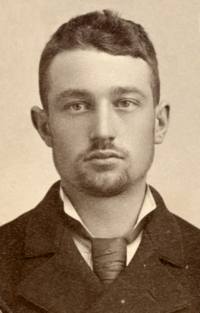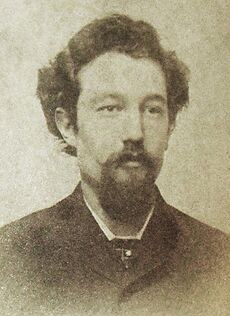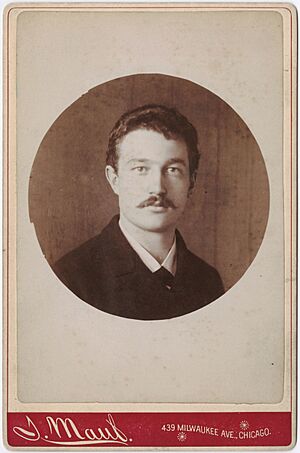Louis Lingg facts for kids
Quick facts for kids
Louis Lingg
|
|
|---|---|
 |
|
| Born | September 9, 1864 |
| Died | November 10, 1887 (aged 23) Chicago, Illinois, U.S.
|
| Occupation | Carpenter |
| Known for | Haymarket Square |
| Political party | Anarchist |
| Parent(s) | Friedrich Lingg |
Louis Lingg (born September 9, 1864 – died November 10, 1887) was a young man from Germany who moved to America. He was an anarchist, which means he believed in a society without government or strict rules. Lingg was wrongly found guilty of being part of a plot related to the 1886 Haymarket Square bombing. He was sentenced to be hanged, but he died in his prison cell just before his execution. Years later, in 1893, the Governor of Illinois, John Peter Altgeld, officially said that Lingg and the other seven men convicted were innocent.
Contents
Louis Lingg: His Life Story
Early Life and Beliefs
Louis Lingg was born on September 9, 1864, in a place called Mannheim, which was then part of the Grand Duchy of Baden in Germany. His father, Friedrich Lingg, was hurt while working in a lumber mill. Louis later wrote that this event, when he was 13, made him see how some people were treated unfairly by others. He felt that people were being used for profit.
From 1869 to 1882, Louis trained to be a carpenter. He then worked in Strasbourg, a city in Alsace. After that, he moved to Freiburg, Germany. There, he joined a group called the Working Men's Educational Society. This group was a socialist organization, meaning they believed in a system where society, not individuals, owned and controlled resources.
To avoid having to join the military, Lingg moved to Switzerland. However, in 1885, the police in Zürich told him he had to leave the country. Soon after, his mother wrote to him. She said her new husband would give him money to move to the United States.
The Haymarket Event
In July 1885, Lingg arrived in New York City. He then traveled to Chicago, Illinois. There, he joined the International Carpenters and Joiners' Union. He had been in Chicago for about seven months before the Haymarket event happened.
On May 4, 1886, Louis Lingg was not at Haymarket Square when a bomb was thrown. This event became known as the Haymarket Riot. An unknown person threw a bomb into a crowd of police officers. However, prosecutors later claimed that Lingg was involved in making the bomb. The day after the bombing, which killed Officer Mathias Degan and other police officers, seven men were arrested. Lingg himself was found hiding on May 14, 1886. He fought with two police officers before they arrested him. On June 21, 1886, Lingg and eight other anarchists were charged with planning a crime together. Lingg and six others were found guilty and sentenced to death.
In Lingg's apartment, police found two round bombs and four pipe bombs. Witnesses told police they saw Lingg in the basement of Greif's Hall the night before the bombing. Other people accused in the plot were also there, including Rudolph Schnaubelt. Schnaubelt was the main suspect for throwing the bomb, but he had fled Chicago. Lingg was tried with seven other anarchists as a group.
Moses Salomon, Lingg's defense lawyer, told the jury that Lingg had a right to have dynamite in his home. Salomon argued that his clients did not plan to hurt any specific person. He said they did not plan to murder Officer Mathias Degan or any police officers, except if they needed to defend themselves.
The lawyer also admitted that his clients did plan to use force together. He said their goal was to use dynamite during a general revolution or strike, but only if they were attacked first. This approach by the defense was unusual. Lingg, as an anarchist, did not believe in the court's authority, so the defense's strategy might not have mattered much to him.
Gustave Lehman, another anarchist carpenter, said that Lingg was part of a strong "armed group" within his carpenters union. Lehman was a lookout outside Greif's Hall. He remembered walking home with Lingg, William Seliger, and two other men. When asked what was happening, Lingg reportedly called them "fools." Chemists testified that the bombs found in Lingg's apartment had a special chemical mix. This mix was similar to pieces of the Haymarket bomb.
Seliger, a carpenter who rented a room to Lingg, gave important testimony against him. Seliger had been charged with murder and other crimes. But the charges were dropped when he agreed to testify for the state. He told the jury that he woke up early on the day of the bombing. He asked Lingg to remove the bombs from the building. Lingg convinced Seliger that helping him build bombs would allow him to remove them that day. Seliger said at least two other men, Ernst Hubner and Herman Mutzenberg, helped them quickly get the bombs ready. These two men did not appear in court. However, they had told police stories that matched Seliger's. None of them were sure how many bombs they made with Lingg that day. Their guesses ranged from 26 to 50.
Lingg supposedly told Seliger he was working too slowly. He said they needed the bombs by the afternoon. Seliger quoted Lingg as saying the bombs would be used that evening against "the police when they came to protect the capitalists." He said Lingg expected trouble on the West Side. Lingg had seen the word "Ruhe" (quiet) in the anarchist newspaper Arbeiter-Zeitung. This was a signal for armed groups to gather.
Seliger testified that he helped move bombs to Neff's Saloon, a place where anarchists met. Men there took the bombs. Seliger then returned to Neff's with Lingg after the bombing. There, a man who came from Haymarket yelled at Lingg, "You are the fault of all of it." Moritz Neff, the anarchist bartender, also confirmed this incident.
During questioning by the defense, Seliger admitted that the police had paid him twice. He also said his wife had been paid by the police. He did not know how many times or how much money she received. But when asked more, he said, "I think twenty or twenty-five dollars." After the trial, Seliger and his family were sent to Germany at the police's expense.
When Lingg spoke to the court at his sentencing, he called Seliger a "bought squealer." He also said the prosecution had not proven that the bombs he made were taken to Haymarket. He also questioned the connection between his bombs and the Haymarket bomb. He pointed out that chemists could only say the metal of his bombs looked similar to the Haymarket bomb. He said the prosecutor even admitted there was a half-inch difference in the bomb sizes. Lingg said he would die happy, believing that many people would remember his words. He said that if they hanged him, others would throw bombs. With this hope, he told the court he did not respect them, their laws, or their power.
His Death and Legacy
On November 6, 1887, four bombs were found in Lingg's prison cell. Louis Lingg died on November 10, 1887. This was the day before he was scheduled to be hanged.
Lingg was buried in the Waldheim Cemetery (now Forest Home Cemetery) in Forest Park, Illinois. Since 1893, his grave has been marked by the Haymarket Martyrs Monument. On June 26, 1893, Illinois Governor John Altgeld officially pardoned all eight men who had been found guilty in the Haymarket Riot. He stated that they were innocent of the crime for which some had died.



